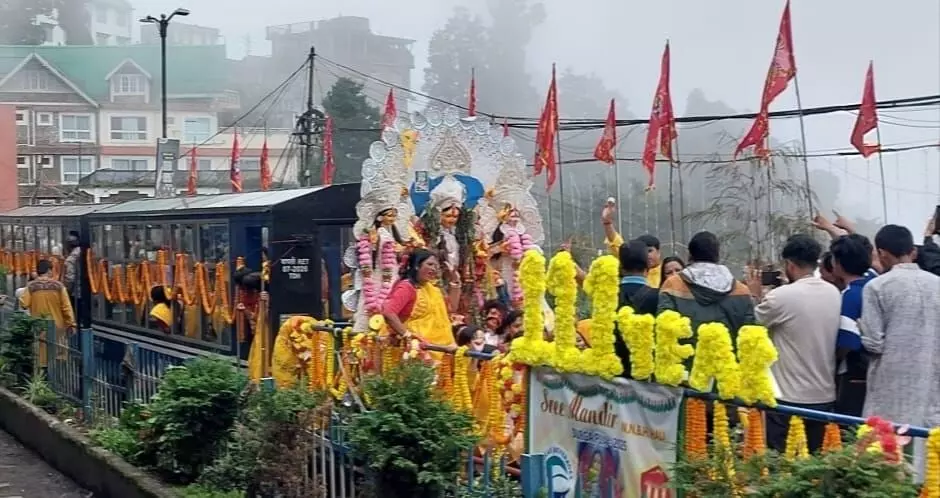Darjeeling’s unique Durga immersion

Darjeeling: This time, Devi Durga decided to return home from the Queen of the Hills riding the Darjeeling Himalayan Railway (DHR). Marking the 111th year of the Durga Puja, the Nripendra Narayan Bengali Hindu Hall (NNBH) chartered the world heritage train to be a part of the immersion procession to Bangla Khola in Rangbul around 12 km from Darjeeling town. During the centenary celebration in 2014, the DHR was also a part of the immersion procession. The immersion procession of this heritage Puja is as unique as the Puja itself. “We are still carrying on with the tradition though with time, we have made some changes. On Thursday, the idol was carried on a bamboo structure, till the Darjeeling Railway Station. From there, it was taken to Bangla Khola by a DHR loco,” stated Saibal Chakroborty, organiser. The procession was an instant hit, with a ‘Dhamsa-Madal’ troupe from Naxalbari and an all women Dhaki team from North 24 Parganas, taking part. Female members of the NNBH Hall, draped in traditional yellow sarees, sang and danced all the way. For Darjeeling, both the Dhamsa-Madal troupe and the all women Dhakis were a first. It was a treat for tourists waiting for joy rides at the station. They too joined in the revelry, dancing to the tunes of the Dhamsa-Madal (traditional tribal drums) and the Dhaks. “I was missing the Durga Puja back home. I never expected to see a Durga idol at the station accompanied by the sound of the Dhaks, playing the Bisarjan (immersion tune.) I was moved to tears. The Dhamsa-Madal was an added attraction,” stated Arpita Chatterjee from Kolkata. Foreign tourists were seen clicking pictures.
In the olden days the immersion procession of this heritage puja used to be accompanied by a police band and the members dressed in traditional attire used to sing devotional songs all along the way. The image used to be carried on a bamboo structure, by the youngsters and taken all over town and immersed in Kakjhora, a spring on the outskirts of the town.
On the way to Kakjhora, the procession used to halt at different affluent Bengali homes for a round of refreshment. The ultimate halt before reaching Kakjhora was the Burdawan Palace. It is said that the Maharaja of Burdwan used to see the face of the image offering a “Mohor” (gold coin) during the early years of the puja. “The idol used to be rested in the palace compound. We used to then conduct the ‘Baran’ ritual, offering sweets and Pan (beetle leaf) to the Goddess. Refreshments used to be served to the members of the NNBH Hall as they rested for a while. From the Burdwan Palace the idol used to head for Kakjhora” reminisced Nandini Mahatab, Maharaj Kumar Ra𝚗i of Burdwan, talking to the Millennium Post.
Nowadays things have changed with the Kakjhora becoming a victim of illegal constructions. After the immersion all the members gather at the hall to take part in “Bijoya Sammelan.” Blessings are sought from the elders, greetings are exchanged and hot Malpuas (sweets) are served. “I came all the way from Kolkata to take part in the 111 year commemorations. Immersion on the DHR was a lifetime experience” stated Shibani Sinha, a member, who now has shifted to Kolkata. Located in Chandmari, the NNBH has a rich history and was built during the British Raj. From 1914 the Bengali community of the Hill town started the Durga Puja in the temple, located in the same premise. Great names like Sister Nivedita, Kazi Nazrul Islam, Acharya J. C. Bose and the great revolutionary Bagha-Jatin had all paid visits to the NNBH Hall.



